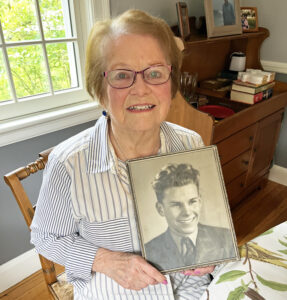On anniversary of D-Day, Canton woman reflects on brother’s sacrifice
By Mary Ann PricePrivate First Class (PFC) Richard Wesley Brown was only 20 years old when he died in France during World War II, one of the thousands of American soldiers killed in Normandy during the D-Day invasions. Canton resident Marie Schuhmacher, his only sibling, does not have any memories of her brother. In letters Brown wrote to his family in the years before he passed away, however, his younger half-sister was on his mind.
The Allied invasion of Normandy, known to most Americans as D-Day, began shortly after midnight on the morning of June 6, 1944 — tomorrow marks the 81st anniversary — with airborne forces parachuting behind enemy lines ahead of a massive amphibious assault on German-controlled terrirtory along France’s northern coastline. Nearly 160,000 troops, led by American, British and Canadian forces, crossed the English Channel that morning as part of the largest seaborne invasion in history. The mission, codenamed Operation Neptune, helped the Allies establish a foothold in the region and kickstarted the successful liberation of western Europe from Nazi control.
Brown was born in 1923 and grew up in Dedham. His mother, Bertha Brown, would later remarry and had a second child, Marie, who was raised in Mattapan. Although she and Richard shared the same mother, Richard was raised by Bertha’s sister and her husband and never lived with the young Marie.
“I have no memory of him,” Schuhmacher said of her brother, “because I was 5 when he died, and for much of that time he was in the service.”
Joining the Army as a teenager, Brown was a member of the 745th Tank Battalion and served on bases in the southern United States as well as Massachusetts before being shipped overseas to the United Kingdom.
During his time in the Army, Brown wrote many letters to his mother, who kept them in perfect condition in a metal box. “My mother saved everything,” Schuhmacher said.
Also in the box, which is now in Schuhmacher’s possession, are other mementos of Bertha’s eldest son, including his birth certificate, Dedham High School diploma, and the telegrams that informed her of his tragic fate.
In 1942, Brown wrote home about working in the Army and reported that he was “going to be a gunner in a tank.” A year later, he was back in Massachusetts at Fort Devens. “I arrived at camp this morning,” he wrote in a letter dated March 24, 1943. “At 9:33 I learned how to make a bed.”
Brown was also able to get an allotment for Marie, which meant that he directed some of his pay to help care for her. Another letter told of how he and his buddies stayed up until 3 a.m. one morning getting ready for inspection.
In a letter dated April 8, 1944, just a few short months before his death, Brown noted that he had sent his mother $80 and that she should use it to buy something nice for herself. He also suggested that she buy a school outfit for Marie, who at the time attended Chittick Elementary in Hyde Park.
“Make sure she is the best-dressed woman in town, because she deserves it,” he wrote.
In another letter dated April 13, 1944, Brown again talked about how quickly his sister was growing up. “I still don’t see how Marie is going on 6,” he wrote. “It seems to me she will be married before I get back.”
Schuhmacher has a map showing the route that Brown’s battalion took. Landing near Glasgow, Scotland, in advance of D-Day, they then traveled to Weymouth, a seaside town on England’s southern coast, before crossing the English Channel to Normandy on June 6, 1944. Seven weeks later, on July 24 of that year, Bertha received a telegram stating that Richard had been declared missing in action on June 7, 1944.
Another telegram arrived on February 16, 1945, creating the only memory that Schuhmacher has of her brother. “My mother got the final telegram saying that he had died and I just remember her screaming,” she said. “That’s an awful memory to have.”
The telegram included an apology from the War Department for the delay in notifying the family of Richard’s passing. Schuhmacher said that her brother was likely killed in a tank.
Brown’s family received acknowledgments from President Franklin D. Roosevelt, the commonwealth of Massachusetts, and the city of Boston regarding his death in action as well as expressions of gratitude for his service. His remains were never found, but his service and sacrifice were recognized by the Army with several posthumously awarded medals, including the Purple Heart and Bronze Star.
One of Schuhmacher’s daughters created a small memorial to her uncle that includes his Bible, Army medals, his high school graduation photo, and a U.S. flag displayed on a table in her home.
Brown’s name appears on Boston’s World War II memorial in the Back Bay Fens and it is also carved on a large memorial wall at the Normandy American Cemetery overlooking Omaha Beach. Referred to as the “Wall of the Missing,” the memorial lists the names of the more than 1,500 U.S. soldiers whose remains were never recovered or identified following the D-Day invasion.
An inscription on the wall above the names reads: “Here are recorded the names of Americans who gave their lives in the service of their country and who sleep in unknown graves. This is their memorial, the whole earth their sepulcher. Comrades in arms whose resting place is known only to God.”
Schuhmacher has never forgotten what her brother did for his country. “People should know about this,” she said. “He gave his life, and that’s the biggest thing you can give.”
Short URL: https://www.thecantoncitizen.com/?p=131761












